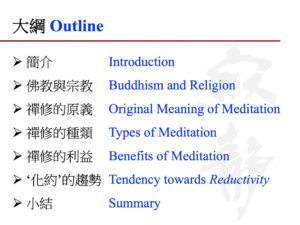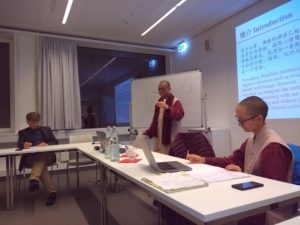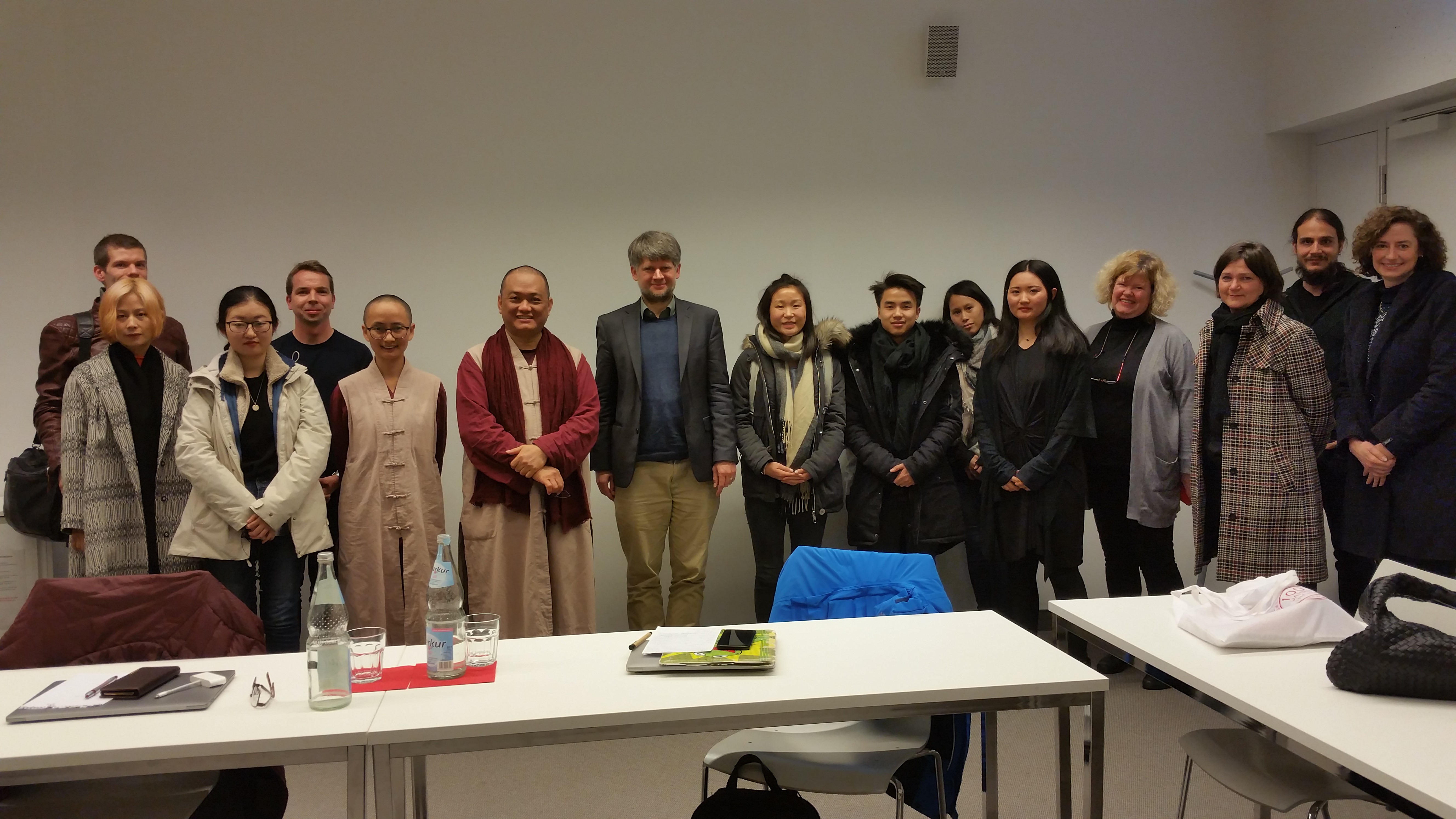2018年11月19日,阿闍梨來到德國大學系列講座的最後一站:柏林自由大學。在這裡,阿闍梨應邀介紹「佛教的禪修」。
Acariya Kaiyin arrived in Berlin to begin the final leg of his German trip. On Nov 19, 2018, he delivered a dhamma talk on Buddhist Meditation at the Free University of Berlin.
本次講座由自由大學東亞研究所漢學系的Meyer教授主持,禪真做即席英譯。共計十幾位當地的學生及教職人員參加。
This dhamma talk was hosted by sinologist Professor Christian Meyer, Department of History and Cultural Studies at the Institute of East Asian Studies. Ven. Chanzhen provided consecutive translations into English. Around a dozen students and teaching faculties attended the talk.
此次講座的受眾,大多對佛教只有初步的了解。因此,阿闍梨從佛教與宗教的關係,禪修是什麼,以及禪修的種類和利益等方面切入,深入淺出地勾勒出佛教禪修的綜合輪廓,引導聽眾以理性和質樸的方式去認知「佛教的禪修」。
Since a large portion of the audience only had a rudimentary understanding of Buddhism, Acariya Kaiyin chose to provide a comprehensive framework upon which the audience could understand Buddhist mediation in plain terms and with a logical approach. As such, he structured his dhamma talk from a broad overview of the relations between Buddhism and religion. He then examined what meditation truly is, before he introduced various types of meditation, benefits of meditation, and so on.
首先阿闍梨從字源學的角度分析佛教(巴利buddhānasāsanaṃ )與西方對宗教(英文Religion)的定義並不一致,指出將「佛教」理解為「佛陀的教法」比理解為西方定義的「宗教」更為貼切,即「佛教」是「佛」陀將自己禪修中的證悟表達出來以「教」導眾生。以此開場既釐清佛教與一般宗教的不同,也點出了禪修於佛教之重要地位。
Acariya Kaiyin started off by explaining that, from an etymological point of view, Buddhism (in Pali, buddhānasāsanaṃ) does not align with the Western definition of “religion”. It would be more appropriate to interpret Buddhism as “Buddha’s teachings” than as a “religion” defined by the West. That is to say, Buddhism is Buddha’s teaching based on his own Awakening through meditations. Such a perspective sets Buddhism apart from other religions, and highlights the fundamental role of meditation in Buddhism.
 接著阿闍梨回歸古印度梵、巴語的bhāvanā(修),從整體的層面來解釋「禪修」的本意,即心智的開展;進而再局部介紹禪修的種類及方法等。在禪修的利益方面,阿闍梨指出,禪修原本的目的是斷煩惱、證涅槃,但在修習過程中也會帶來一些附加的世間利益。在當今社會,更有將禪修與科學、文化、心裡治療等相結合之趨勢,這些未嘗不是佛教一個新的契機。
接著阿闍梨回歸古印度梵、巴語的bhāvanā(修),從整體的層面來解釋「禪修」的本意,即心智的開展;進而再局部介紹禪修的種類及方法等。在禪修的利益方面,阿闍梨指出,禪修原本的目的是斷煩惱、證涅槃,但在修習過程中也會帶來一些附加的世間利益。在當今社會,更有將禪修與科學、文化、心裡治療等相結合之趨勢,這些未嘗不是佛教一個新的契機。
After that, Acariya Kaiyin examined the meaning of meditation through its origins in ancient Indian languages. The word bhāvanā, as used in Sanskrit and Pali languages, refers to the development or cultivation of the mind. He then went on to introduce various types and methods of meditation. In regard to the benefits of meditation, Acariya Kaiyin pointed out that the original goal of meditation was to eradicate all defilements and to attain Nibbāna, but the practice can bring about some worldly benefits. Recent trends to incorporate meditation with science, culture, psychotherapy etc. might prove to be an opportunity to extend Buddhism’s reach.
此次講座的內容,既涉及到佛教禪修於當今社會之體用,又不忘強調佛法獨特的 「出世」本位。這「出世」為體、「入世」為用的特性,也激起聽眾對二者關係的思考。有一位學生提到,佛教最終目的是「涅槃」,但同時又強調「入世」,此二者是否矛盾呢?另外,來自德國洪堡大學的研究員、學者李可(Friederike Assandri)也問到,在佛教發展歷史中,「菩薩」精神是否一直延續呢?
「出世」本位。這「出世」為體、「入世」為用的特性,也激起聽眾對二者關係的思考。有一位學生提到,佛教最終目的是「涅槃」,但同時又強調「入世」,此二者是否矛盾呢?另外,來自德國洪堡大學的研究員、學者李可(Friederike Assandri)也問到,在佛教發展歷史中,「菩薩」精神是否一直延續呢?
This dhamma talk did not only cover the practice of Buddhist meditation in today’s society, but also reminded us the distinctive core of liberation in Buddhism. The duality of this world-transcending core with socially engaged acts was thought-provoking for the audience. One student commented that Buddhism’s ultimate goal in its pursuit of Nibbāna and its emphasis on being socially active seemed rather paradoxical. Professor Friederike Assandri, Research Associate at Humboldt University and scholar, also asked whether the ideal of Bodhisattva has been upheld throughout the history of Buddhism.
針對這一系列的問題,阿闍梨首先解說到佛教所強調的「涅槃」即指滅除煩惱,但一個人證得涅槃不夠,佛教希望更多人證得涅槃。正如佛教的教育,強調「五明」,其中「內明」是朝向「涅槃」,但只有「內明」是不夠的,我們還要學習其它「聲明」、「因明」、「醫方明」、「工巧明」其他的四明才能幫助到他人。而「菩薩」的精神,也一直延續到現在南、北、藏傳佛教各個方面。另外還有聽眾問到關於「人間佛教」及佛教宗派及研究的問題,阿闍梨都一一作了回答。
To answer these questions, Acariya Kaiyin clarified that while Buddhism’s concept of Nibbāna refers to the eradication of defilements, it is not enough if only one person attains that state. Buddhism’s ideal is to have more people attain Nibbāna. Just as in the five classes of knowledge (pañcavidyā), a Buddhist should not confine his/her education in inner knowledge (adhyātma vidyā), with the goal of attaining Nibbāna. A Buddhist should also acquire knowledges of language (śabda vidyā), logic (hetu vidyā), medicine (cikitsā vidyā), fine arts and crafts (śilpa-karma-sthāna vidyā) in order to become competent in guiding more people. And the spirit of Bodhisattva continues to this day in all traditions in Southern, Northern and Tibetan Buddhism. Questions were also raised with regard to Humanistic Buddhism, different Buddhist schools and Buddhist research. Acariya Kaiyin answered them accordingly.
文:禪真 / 英譯:陳家恩 / 圖:Dr. Friederike Assandri, Prof. Christian Meyer
